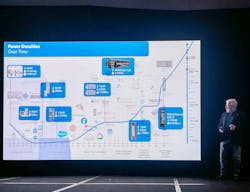AI Infra Summit 2025 Insights: AI Factories at the Core of the Fifth Industrial Revolution
Key Highlights
- AI data centers are entering a transformative phase, dubbed the 'iPhone moment,' revolutionizing infrastructure with innovations in hardware, software, and sustainability.
- Industry leaders like Meta and NVIDIA are pushing the boundaries of AI infrastructure, focusing on massive GPU deployments, energy efficiency, and flexible architectures.
- Advances in memory technology, chip design, and networking are critical to overcoming bottlenecks and enabling scalable, efficient AI workloads.
- The rise of neocloud providers and innovative financing models is diversifying the AI infrastructure ecosystem, fostering competition and accelerating growth.
- Design philosophies are shifting towards flexible, modular, and sustainable data centers capable of adapting to rapid technological and workload changes.
Data centers have long been the hidden engines powering the digital age, but today they stand at the forefront on the cusp of a profound transformation—an inflection point industry leader Phill Lawson-Shanks has aptly termed AI’s “iPhone moment.” Much like the smartphone revolution that upended technology and society two decades ago, the confluence of hyperscale AI workloads with groundbreaking infrastructure innovation is ushering in what can only be described as the fifth industrial revolution.
The AI revolution is about much more than increased power dominating headlines, but will require a complete overhaul to every aspect of our design and operations, wherein the architecture of data centers, the complexity of AI factories, and the integration of compute, memory, networking, and sustainable power must coalesce into a dynamic ecosystem driving unprecedented potential. The exponential scaling of AI models requires groundbreaking innovation across every layer of infrastructure, fundamentally reshaping how technology supports human progress.
The ecosystem that is rapidly emerging will redefine economic growth and industrial development over the next several decades, unlocking new industries, accelerating discovery, and transforming markets, rendering the AI data center the apex for society’s most powerful innovations. Last month's AI Infra Summit 2025 (Sep. 9-11) in Santa Clara crystallized this emerging reality into a shared vision that blends opportunity with responsibility.
Meta as a Visionary Building Necessary AI Foundations
Meta’s keynote presentation underscored both the scale of the challenge and horizon of opportunity. The company’s roadmap toward massive GPU factories, such as the 1GW Prometheus cluster scheduled for deployment by late 2026, demonstrates a commitment to pushing infrastructure limits. Managing complexity at this scale demands an ecosystem that is open, diverse in suppliers, and resilient—a model not only of technical excellence but adaptive governance in a global system.
Meta’s journey from early AI-driven recommendation engines to current hyper-scale GPU deployments illustrates how deeply integrated AI and infrastructure have become. This interdependence will grow more profound as more applications embed AI and the data supporting these workloads grow exponentially. Their openness to sharing standards and commitment to supplier diversity will likely influence ecosystem stability and innovation permeating the entire industry.
At its core, Meta’s vision represents an essential truth about AI infrastructure: scale creates complexity that can overwhelm traditional approaches to design, management, and collaboration. Yet, by embracing these challenges, companies forging ahead set foundational pillars upon which a new technological era will be built: one that balances scale with agility and innovation with sustainability.
NVIDIA’s AI Factory: Engineering the Future of Compute
NVIDIA’s keynote illuminated the invisible but indispensable heart of the AI revolution—the AI factory. This factory blends hardware and software innovation to achieve performance breakthroughs that transcend traditional limits. Technologies such as disaggregated rack-scale GPUs and the novel 4-bit floating point numerical representation move beyond incremental improvements; they redefine what is achievable in energy efficiency and cost-effectiveness.
The software ecosystem NVIDIA fosters, including open-source frameworks like Dynamo, enables unprecedented flexibility in managing inference workloads across thousands of GPUs. This adaptability is crucial given the diverse, dynamic demands of modern AI, where workloads can fluctuate dramatically in scale and complexity. The continuous leap in benchmark performance, often quadrupling hardware capabilities through software alone, continues to reinforce their accelerated innovation cycle.
NVIDIA’s framing of AI factories as both technology platforms and business enablers highlights an important shift. The value computed is not merely in processing raw data but in generating economic streams through optimizing speed, reducing costs, and creating new AI services. This paradigm is central to understanding how the new industrial revolution will operate through highly efficient AI factories uniting production and innovation.
AWS and the Cloud’s Role in Democratizing AI Power
Amazon Web Services (AWS) represents a key pillar in making AI capabilities accessible across the innovation spectrum. AWS’ focus on security and fault tolerance reflects maturity in cloud design, ensuring trust and resilience are priorities alongside raw compute power. The evolution towards AI agents capable of specification-driven operations signifies a move beyond traditional computing paradigms towards contextual, autonomous AI services embedded deeply in workflows.
Their launch of EC2 P6-B200 instances with next-generation Blackwell GPUs and specialized Trainium chips represents a continual drive to optimize AI training and inference at scale and out-of-box improvements in performance of 85% reduction in training time; their P6E-B200 further increases the powerful GPU offering to evolve performance. These advances reduce training times significantly, enhance performance per watt, and enable diverse customers from startups to enterprises to benefit from world-class AI infrastructure without massive capital expenditures.
AWS shared the example of Perplexity achieving a 40% reduction in AI model training time using AWS SageMaker HyperPod encapsulates the tangible business benefits of cloud innovations. By managing complexity behind the scenes and helping customers automate key training steps, AWS lowers barriers, speeds time to market, and broadens AI’s impact across industries.
Breaking Barriers Beyond Compute
These key players are paving a path for the entire industry, in which innovations in AI infrastructure go far beyond faster chips. A major theme at the summit was breakthroughs in memory technology and chip design that address longstanding bottlenecks. Kove’s work on memory virtualization represents a leap towards breaking free from the physical confines of traditional DRAM, enabling far larger and more flexible AI models than were previously possible.
Meanwhile, Siemens demonstrated how AI-driven electronic design automation is redefining semiconductor and system design processes. The projected trillion-dollar semiconductor market by 2030 will be shaped by how quickly chip manufacturers can harness AI to accelerate design checks, optimize components, and meet ever-increasing model complexity.
Together, these advances suggest a future where AI hardware infrastructure is not merely bigger but also smarter and more adaptable. This is critical as data centers evolve into living ecosystems continuously reconfiguring to meet changing workload demands and sustainability goals.
Neoclouds and Ecosystem Synergies: Accelerating Growth Through Collaboration
The rise of neocloud providers signals a still maturing, diversifying AI infrastructure market. These nimble, specialized operators complement hyperscalers by serving niche enterprise segments and experimenting with innovative business and financing models. Their agility accelerates infrastructure availability and expands overall market capacity, helping ease supply bottlenecks.
However, as we've covered in previous articles, this will shake out over the coming few years and many will not survive the capital demands and customer acquisition hurdles they will face in this CapEx-heavy, speed-to-ROI market. Financing remains a critical frontier, with neoclouds leveraging risk-sharing mechanisms like leasing real estate and hardware, parent guarantees, and collateralized GPU investments to compete. Companies like Coreweave have demonstrated how aggressive financing and strategic acquisitions can rapidly transform market profiles with new capital and scale.
This ecosystem synergy fosters competition that drives down costs, accelerates delivery timelines, and spurs innovation. The industry is transitioning from one dominated by a few hyperscalers to a vibrant landscape where varied players co-create solutions, amplifying AI’s growth potential.
Networking and Data Movement: The Hidden Layer of Efficiency
Optimizing data movement within and between data centers is one of the most overlooked yet crucial frontiers. Cornelis Networks highlighted how current AI infrastructures spend substantial cycles on communication overhead and error recovery, throttling utilization and profitability. Achieving lossless, congestion-free networking that scales to hundreds of thousands of endpoints unlocks significant efficiency gains. Translation: bottom line gains.
Open fabric protocols and interoperable network designs are enabling secure, high-throughput, low-latency data paths that reduce costly retransmissions. This is fundamental to maximizing GPU utility and shortening time-to-insight for AI workloads. Networking innovation, thus, is not just a utility task but a core enabler of AI business outcomes.
Efficient, robust networking makes every watt of compute count, affecting the total cost of ownership and accelerating the feedback loop for AI training and inference. It acts as the circulatory system for the AI factory, ensuring that data flows efficiently to where it is needed most.
Designing for the Future: Flexibility and Sustainability
The metaphor of the AI data center’s “iPhone moment” extends deeply into design philosophies. Traditional rigid constructs are giving way to flexible architectures embracing liquid cooling, distributed and onsite power sources, including natural gas and small modular reactors, as well as modular structures that evolve over time.
Flexibility is vital given the rapid pace of hardware evolution and workload shifts. Data centers constructed today must accommodate technologies still emerging and plan to scale across decades. Sustainability concerns also drive this shift, as operators continually seek to reduce energy consumption while meeting growing power demands with clean, reliable sources.
By integrating these principles, AI data centers become dynamic entities finely tuned to their operational, environmental, and economic contexts. This approach balances immediate project needs with long-term viability, embodying the industrial revolution’s spirit of enduring, scalable progress.
Welcome to the Fifth Industrial Revolution
AI data centers are more than warehouses of connected compute, ushering in a nexus of new industry innovation defined by intelligent automation, hyper-connectivity, and economic transformation. Phill Lawson-Shanks’ “iPhone moment” analogy captures the essence of this evolutionary leap: just as the smartphone remade society, AI data infrastructure will redefine how technology powers human potential.
The AI Infra Summit reinforced an inspiring shared vision: a future where integrated hardware, software, networking, and sustainability innovations converge to unlock vast opportunity. This fifth industrial revolution challenges all stakeholders to build infrastructure that is not only powerful but resilient, open, and adaptive.
For technology developers, investors, policymakers, and operators alike, the mandate is clear: the revolution has begun, and its shape will be determined by foresight, bold innovation, and the most critical of all—open collaboration. The AI data center is poised to transform economies and society, and the time to act, to build for tomorrow’s intelligent future, is now.
About the Author

Melissa Reali
Melissa Reali is an award-winning data center industry leader who has spent 20 years marketing digital technologies and is a self-professed data center nerd. As Editor at Large for Data Center Frontier, Melissa will be contributing monthly articles to DCF. She holds degrees in Marketing, Economics, and Psychology from the University of Central Florida, and currently serves as Marketing Director for TECfusions, a global data center operator serving AI and HPC tenants with innovative and sustainable solutions. Prior to this, Melissa held senior industry marketing roles with DC BLOX, Kohler, and ABB, and has written about data centers for Mission Critical Magazine and other industry publications.


